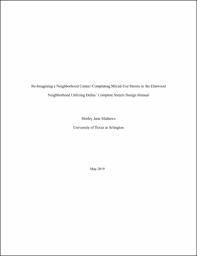
ATTENTION: The works hosted here are being migrated to a new repository that will consolidate resources, improve discoverability, and better show UTA's research impact on the global community. We will update authors as the migration progresses. Please see MavMatrix for more information.
Show simple item record
| dc.contributor.advisor | Anjomani, Ardeshir, PhD | |
| dc.contributor.author | Mathews, Shirley Jane | |
| dc.date.accessioned | 2019-10-18T17:58:23Z | |
| dc.date.available | 2019-10-18T17:58:23Z | |
| dc.date.issued | 2019-05 | |
| dc.identifier.uri | http://hdl.handle.net/10106/28701 | |
| dc.description.abstract | Walkable neighborhoods with adjacent commercial centers have the ability to encourage mode shifts to walking, bicycling, or transit. Mode shifts from single-occupancy vehicles (SOV) to the destinations within a neighborhood center of Elmwood's size may result in approximately 3,000 SOV trip reductions per day (H-GAC, 2018). This study examines the Dallas Complete Streets Design Manual (2016) and applies the Dallas Complete Streets Vision to a 1,400 foot (.3 mile) segment of Edgefield Avenue, adapting the guidelines to Edgefield Avenue with site-specific consideration. It refers to the Dallas Complete Streets Design Guidelines in the development of a complete street proposal for Edgefield Avenue. This study consists of an existing conditions review, a site conditions analysis, a community-visioning workshop, and culminates in a streetscape cross-section proposal to address the pedestrian, intersection, and street zones. Recommendations are made for potential sources of funding, and next-steps for the Elmwood Neighborhood Association. | en_US |
| dc.language.iso | en_US | en_US |
| dc.publisher | University of Texas at Arlington | en_US |
| dc.subject | Elmwood Neighborhood, Dallas, Texas | en_US |
| dc.subject | Edgefield Avenue, Dallas, Texas | en_US |
| dc.subject | walkable neighborhoods | en_US |
| dc.subject | Dallas Complete Streets Design Manual | en_US |
| dc.title | Re-Imagining a Neighborhood Center: Completing Mixed-Use Streets in the Elmwood Neighborhood Utilizing Dallas' Complete Streets Design Manual | en_US |
| dc.type | Technical Report | en_US |
Files in this item
- Name:
- Re-Imagining a Neighborhood ...
- Size:
- 19.93Mb
- Format:
- PDF
- Description:
- Re-Imagining a Neighborhood ...
This item appears in the following Collection(s)
Show simple item record


